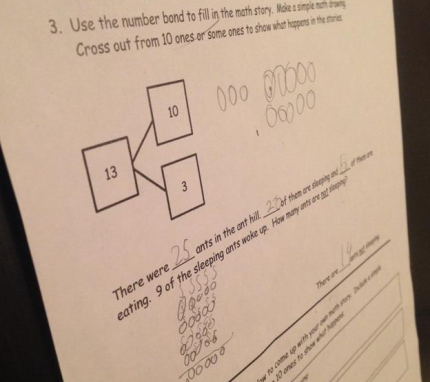Some of the major problems with Common Core is that the materials are made by people who don’t understand what is being taught, teachers who don’t know how to teach it, and the use of jargon that makes Cockney rhyming slang seem transparently obvious.
Take for example the following:
My 9 year old sisters math homework with this "common core" shit. WHAT ARE THESE DIRECTIONS. pic.twitter.com/GNw0uumhuR
— Lauren ✌️ (@HollaAtMe_Baby) January 21, 2014
If presented in a proper manner, it does make sense. Adding 3 to 7 will result in 10, and taking 3 from the other 7 will result in 4, which makes adding the two numbers easy. Of course, this only makes sense if the student already understands the basics of addition and subtraction, as well as intuitively understands that one is rounding up one number to 10 while rounding down the other numbers equivalently. The problem with the above example, is that is does not explain why you split 7 into 3 and 4. The student would just go through the motion without actually understanding why it is done the way it is!
Unfortunately, these things are not explained. Furthermore, instead of explaining it, children are forced into word problems that often turn into word puzzles and trick questions. Take for example, the following:

The text reads:
“Use the number bond to fill in the math story. Make a simple math drawing. Cross out from 10 ones or some ones to show what happens in the stories.
“There were __ ants in the ant hill. __ of them are sleeping and __ of them are eating. 9 of the sleeping ants woke up. How many ants are not sleeping?”
The number of act eating are irrelevant. Clearly, you determine how many ants were already away by subtracting the number of sleeping ant from the total, and then add the nine ants that awoke. But this is easy to figure out if you already understand basic arithmetic. Children just leaning can become confused, especially when the red herring of ants that are eating is thrown in. Unless they understand the principles, they might not understand how to derive the relevant information and arithmetically manipulate it.
Sadly, often this results in confusing jargon being used to obfuscate the lesson, thus preventing the parents from helping teach their own children. In essence, this means that parents are purged from the educational process and professional “educators” are more secure in their public school satrapies.
A perfect example can be seen below:
Kindergarten math homework. Makes no sense whatsoever. #CommonCore should be ashamed. pic.twitter.com/emnxjUwRrU
— Chris Zoller (@ChrisZFitness) February 27, 2014
It just goes to show that the government will not trust the future of what it considers to be its children to mere parents.







That math question is appalling. What’s wrong with a nice number line for addition and subtraction, and a grid for memorizing multiplication? Nothing! The fact that parents would then be able to help their children with homework (and the learning approach would be familiar everywhere), well, that’s what “rigor” and “robust” mean to me.
I partially disagree with you here:
The Common Core developers weren’t professional educators. The math and English CC standards were created by politically connected public policy “experts” and NGO administrators. From what I’ve observed and been told, good public school teachers vigorously oppose the Common Core. Also, the teaching style and curricular content in English and math formerly used by U.S. public schools and reputable private schools e.g. Jewish day school, Catholic parochial school, were similar. Effective too. We survived very well without a Department of Education! We’d probably be better off without Secretary Duncan and the massive (croney contract awarded) curriculum development and technology expenditures that he established.